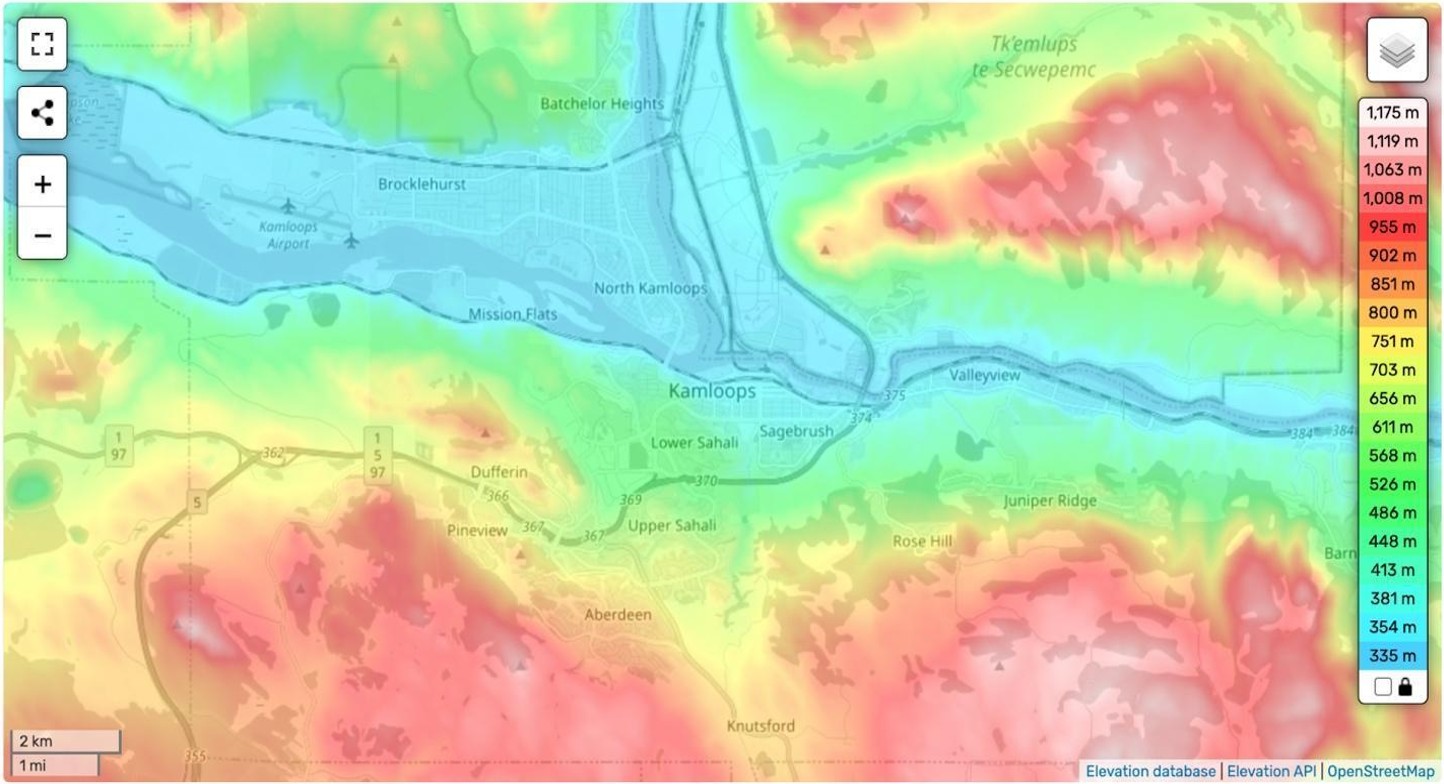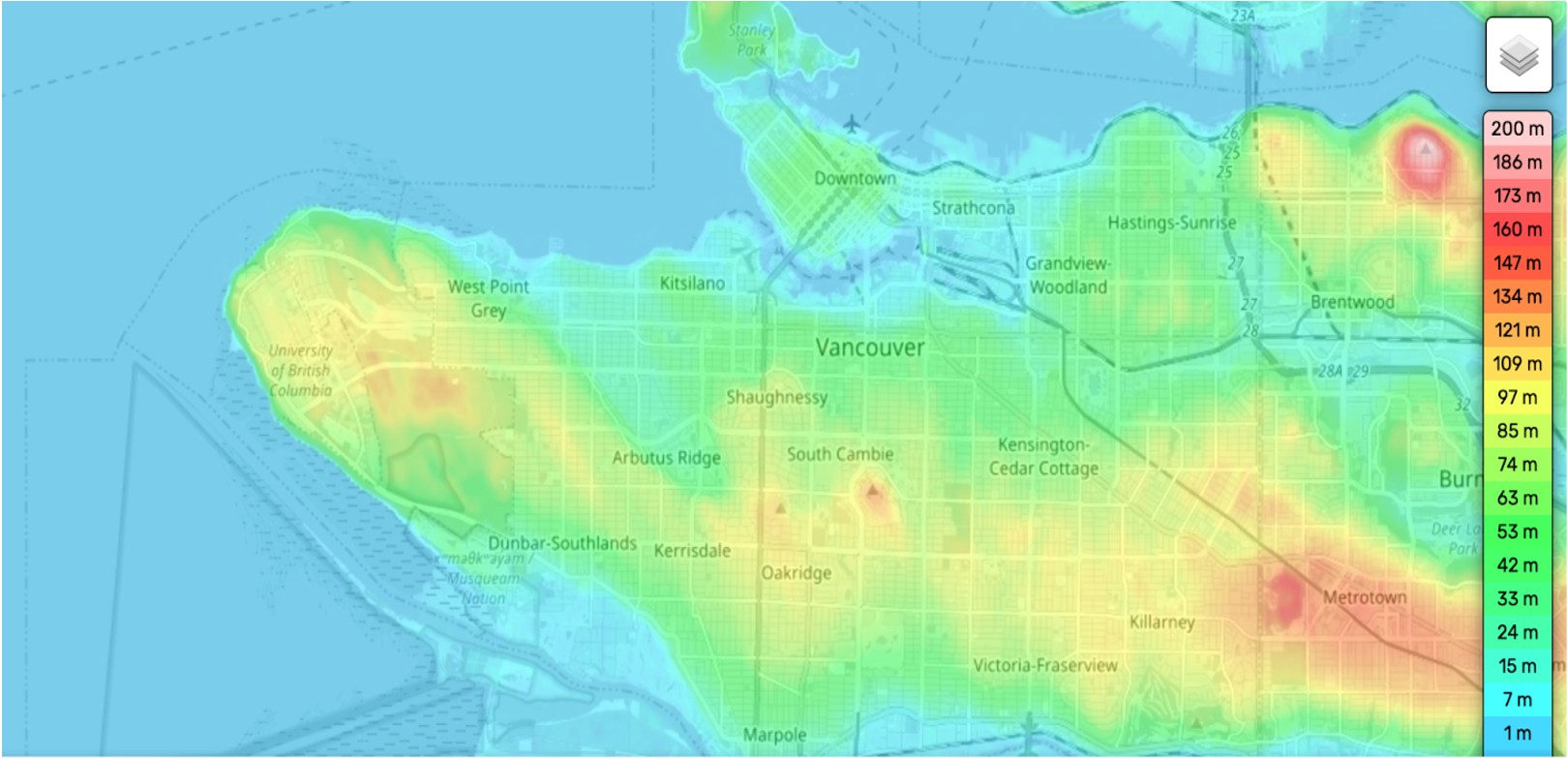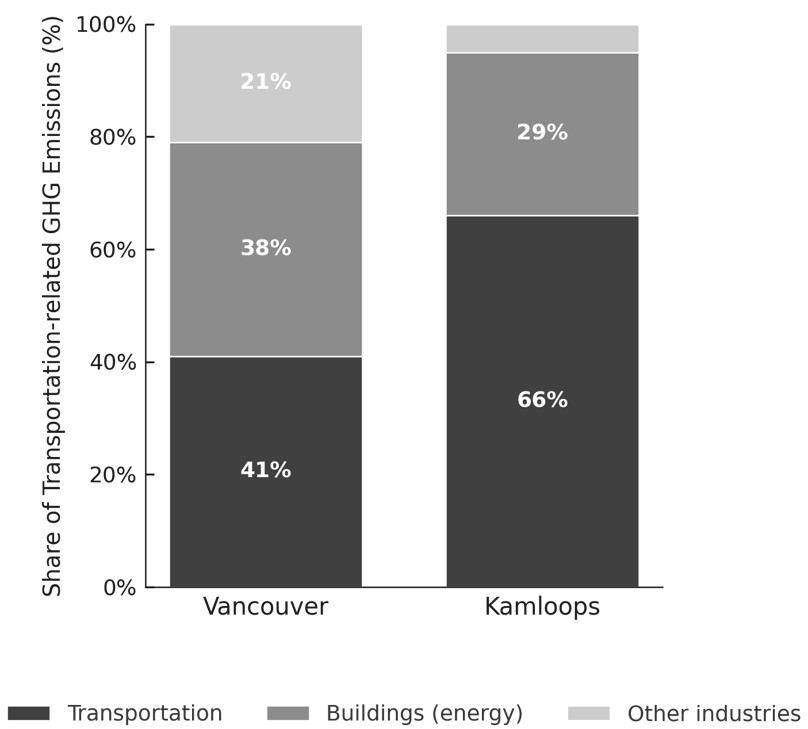
Emma Chretien & Paolo Murphy
Thompson Rivers University
Transportation systems shape urban sustainability, health, and everyday life. This study compares Vancouver and Kamloops, B.C., to assess how infrastructure influences travel behavior and per-capita transportation emissions. Using publicly available government data, planning documents, statistical records, and prior studies, supplemented by lived experience, we analyze mode shares, transit accessibility, walkability, and emission profiles. Vancouver's integrated network of frequent transit, protected cycling routes, and transit-oriented neighbourhoods corresponds to lower transportation emissions at 39 percent and higher active-mode use of walking and cycling at 29 percent. In Kamloops, car dependence dominates (88% of trips), and transportation contributes a larger share of emissions at 66 pc. Kamloops' fragmented walkability and topographic constraints further limit alternatives. While geographic and environmental factors preclude a simple replication of Vancouver's model, targeted improvements in Kamloops-such as enhanced bus frequency and coverage, connected and protected cycling infrastructure, and walkable, mixed-use neighbourhood design-could deliver meaningful reductions in emissions and co-benefits for public health and social inclusion. The findings highlight that even in car-dependent mid-sized cities, incremental, context-sensitive interventions in sustainable transport can yield outsized gains.
Keywords: sustainable transport, mode share, transit accessibility, walkability, per-capita emissions, mid-sized cities
Transportation systems have a significant impact on a city's health, well-being, and environmental sustainability. The amount of physical activity ingrained in daily life, the quality of the air people breathe, and how people interact with their city are all influenced by these systems. The transportation systems available in Canadian cities vary greatly. This research examines the differences between Vancouver and Kamloops, chosen for their stark contrasts in urban planning and sustainability efforts.
Vancouver boasts an extensive public transportation system with a strong commitment to green initiatives. In contrast, Kamloops is heavily reliant on cars and has limited transportation options, with fewer sustainability measures in place. The objective of this research is to analyze the differences in transportation systems between Kamloops and Vancouver and their effects on the environment, physical health, and well-being of residents.
For this research, Vancouver and Kamloops are defined according to their geographical boundaries as cities, not census metropolitan areas. The city of Vancouver has a population of 662,248 with a density of 5,749.9/km2. This makes Vancouver the most densely populated city in Canada (Statistics Canada, 2021), demanding the necessary transportation infrastructure to accommodate its population. Due to Vancouver's location-directly on the coast of the Georgia Strait, which leads to the Pacific Ocean-the elevation of the city is quite low, with an average elevation of just 34 m. Its coastal climate is much milder than many areas of B.C., rarely receiving harsh snowfall with a yearly average of 33.6 cm (Vancouver Weather Stats, 2025), but infamously receiving a large amount of rain at around 1,100 mm per year (Vancouver Weather Stats, 2025).
Kamloops is a city of 97,902 residents with a density of 328.6/km2 (Statistics Canada, 2021). The main reason for this large discrepancy in density is, aside from the population, the physical area of Kamloops is nearly three times larger than that of Vancouver at 298 km2 versus Vancouver's 115 km2. This comparatively low population over such a large region is a substantial factor behind why Kamloops is so dependent on cars for transport, as service to many areas would be inefficient. Exacerbating this car dependency is the geography and climate of Kamloops. Kamloops is located in the southern interior of B.C. with an extremely hilly topography, having a difference between its maximum and minimum elevation of 1,409 m (Topographic-map.com, n.d.). Kamloops's climate is much more severe than Vancouver's, being semi-arid, with hot summers and mild winters with temperatures ranging from 0-5 Celcius (UBC, n.d).
Given the increased focus on mitigating climate change and the part urbanization plays in environmental sustainability, this topic is especially relevant today. In addition to lowering greenhouse gas emissions, sustainable transportation encourages healthier lifestyles. This study compares Kamloops and Vancouver in order to show the advantages of sustainable transportation systems and pinpoint areas where Kamloops needs to improve. The reason for enhancing transportation in Kamloops, rather than in both Kamloops and Vancouver, is that Kamloops is not making enough progress in this area to have a positive impact on sustainable living. In the 2021 report, the City of Kamloops reported that two-thirds of their greenhouse gases (GHG) emissions in 2017 were due to gas and diesel-powered vehicles (City of Kamloops, 2021). In contrast, the City of Vancouver reported that 40% of their GHG emissions were from transportation. While these numbers are not where the city aims to be, there are obvious positive implications for the City of Vancouver in reducing GHG emissions through active transportation.
This study compares the transportation systems of Vancouver and Kamloops to evaluate how differences in infrastructure design influence environmental sustainability, public health, and the quality of life for residents. This paper addresses a research gap in the literature on Canadian sustainable transportation: while large cities and urban centers such as Vancouver are often studied, mid-sized cities such as Kamloops remain underexplored. This study contributes by examining how Kamloops, as a smaller, less dense city, might adapt lessons from Vancouver to advance its transportation system toward a more sustainable future.
The central research question guiding this study is:
How can Kamloops adopt and adapt sustainable transportation practices that are successfully demonstrated in Vancouver, to improve accessibility, reduce greenhouse gas emissions, and promote healthier urban living?
The following section provides an overview of the relevant literature, followed by the methodology, the research findings, and finally, the results and policy implications.
This literature review will provide an overview of the impacts of transportation on greenhouse gas (GHG) emissions, the benefits of active transportation, the transportation methods available in Vancouver, the transportation methods in Kamloops, and a comparative analysis of the two.
Urban transportation systems significantly impact GHG emissions, air quality, and urban livability. Cities investing in public transit, cycling, and pedestrian infrastructure experience lower emissions and improved air quality (Litman, 2020). Canada's CleanBC Roadmap to 2030 also emphasizes promoting active transportation and transitioning to zero-emission vehicles to reduce transportation-related emissions (Government of British Columbia, 2021).
Vancouver is recognized for its integrated and sustainable transportation system, prioritizing public transit, cycling, and walking. The Vancouver Transportation 2040 Plan promotes reduced car dependency and increased active transportation (City of Vancouver, 2019). Key features include public transit expansion, which includes extensive bus, SkyTrain, and SeaBus networks that provide viable alternatives to car travel. Cycling infrastructure includes well-developed, protected bike lanes and traffic-calmed streets. Bikeshare services with stations are available across the city.
Kamloops, a mid-sized city, is heavily dependent on vehicles, with limited public transit and active transportation options. According to the City of Kamloops' Community Climate Action Plan (2021), transportation methods consist of 88% car, 5% transit, and 7% active transportation. Transportation accounts for 66% of the city's GHG emissions, with passenger vehicles contributing 49%. Regarding walkability and accessibility, it is highly variable, with downtown being walkable but suburban areas lacking infrastructure. Public transit only accounts for 5% of commutes due to several limiting factors, such as only 5% of bus stops being sheltered, making public transport less attractive in harsh weather, not all areas of the city being serviced, and some of the ones that are serviced are not receiving regular enough service to make use convenient (City of Kamloops, 2022).
By contrast, Vancouver's lower car dependency is largely the result of its high population density, which supports efficient transit networks and reduces reliance on personal vehicles. Extensive and comprehensive land use planning over multiple decades has prioritized mixed use neighbourhoods, making public transit both convenient and reliable. Kamloops on the other hand, faces challenges rooted in its dispersed geography, steep topography, and car dependent urban planning, all of which make it difficult to replicate Vancouver's sustainable transportation model and practices.
Although both Vancouver and Kamloops acknowledge the value of sustainable transportation, their strategies diverge greatly because of differences in geography, demographics, and policy variations. Vancouver's success is attributed to its extensive public transit network, cycling infrastructure, and integrated urban planning. In contrast, Kamloops faces challenges related to car dependency and limited active transportation options. Research by Voss et al. (2016) demonstrates the positive health impacts of public transportation, especially in terms of physical activity. This study illustrates how public transit trips serve as a significant source of physical activity for older adults. These findings underscore the importance of transit systems not only for reducing emissions but also for promoting health by encouraging walking and other forms of activity, which are integral to daily routines for many residents.
Understanding the unique geographical and climatic characteristics of each city is crucial, as these factors heavily influence transportation infrastructure and modal choices.
Kamloops is situated in a valley at the confluence of the North and South Thompson Rivers, surrounded by rugged, mountainous terrain. The city spans an area of approximately 299.25 km2 with an elevation of about 345 meters above sea level (Statistics Canada, 2021). The city experiences a semi-arid climate, characterized by hot summers with temperatures often reaching 35−40°C and relatively mild winters compared to other Canadian cities, with about 20 days per year where temperatures drop below −10°C (Kamloops Weather Stats, 2025). The hilly terrain and steep roads in Kamloops present challenges for cyclists and pedestrians, making active transportation less appealing, especially in areas with significant elevation changes, as illustrated in Figure 1. This leads residents to choose more convenient modes of transportation, such as driving. Kamloops suffers from an underdeveloped public transportation system. Steep grades can limit bus accessibility, and "loop" road designs following ridgelines create pockets of development that are difficult to service effectively. Designing efficient bus routes is complicated by the topography, which discourages residents from choosing public transportation as their preferred mode of transport.
The City of Vancouver is located on the Burrard Peninsula, featuring a blend of flat and gently rolling terrain, as illustrated in Figure 2. Elevations range from sea level to approximately 152 meters (500 feet) above sea level, with the highest point being Little Mountain (Queen Elizabeth Park). The North Shore Mountains provide a dramatic backdrop to the north but are outside the city limits. Vancouver has a temperate oceanic climate with mild, rainy winters and warm, dry summers. The proximity to the Pacific Ocean and the protection of Vancouver Island contribute to its status as one of the warmest cities in Canada. The relatively flat terrain and mild climate make Vancouver conducive to cycling and walking year-round. This has facilitated the development of extensive bike lanes and pedestrian pathways. The flat landscape allows for straightforward construction and operation of public transit infrastructure, including buses and the SkyTrain system. The well-integrated and well-designed public transportation systems make it an accessible and reliable transportation method for residents.
The challenging topography and extreme summer and winter temperatures in Kamloops discourage active transportation modes. Residents may prefer personal vehicles equipped with air conditioning and heat to navigate challenging terrains comfortably. Public transit routes must account for elevation changes and unexpected weather, potentially leading to longer and less efficient routes. The favourable terrain and climate of Vancouver encourage the use of bicycles and walking as viable daily transportation options. The city's investment in cycling infrastructure, such as protected bike lanes, reflects this preference and supports it. Public transit benefits from the ease of constructing routes on flat land, contributing to a more efficient system.

Figure 1. Topographic map of Kamloops showing elevation gradients (minimum = 333 m, mean = 833 m, maximum = 1,742 m). (Source: Topographic-map.com, n.d.)

Figure 2.Topography of Vancouver (min = −4 m, mean = 34 m, max = 156 m). (Source: Topographic-map.com, n.d.)
This research uses a comparative analysis approach to evaluate the transportation systems in Vancouver and Kamloops. Data was collected from government reports and urban plans such as the City of Kamloops Community Climate Action Plan (2021), Vancouver Transportation 2040 Plan (2019), and CleanBC Roadmap to 2030. Additionally, statistical data and public records were used for information on, mode share percentages, GHG emissions data, and infrastructure details from municipal reports and public databases. Further, academic literature on sustainable urban mobility, health impacts of transportation systems, and environmental policy frameworks was used. The analysis focuses on key metrics such as mode share, GHG emissions, public transit infrastructure, walkability, topography, weather, and cycling infrastructure to compare the effectiveness and sustainability of the two cities' transportation systems.
Vancouver's extensive transport systems operate at higher frequencies, covering much more of the city. This makes public transport a more convenient option for Vancouverites' daily commutes, being five times more popular than for Kamloops residents (27% vs. 5%), as shown in Table 1. Additionally, the smoother geography and greater investment in bike lanes allow active transport to be even more popular than public transport in Vancouver, at 29%-over four times the percentage of Kamloops residents at 7%. These two differences are the main factors explaining the stark contrast in GHG emissions from transport between the two cities, with 66% of all emissions in Kamloops coming from transportation versus the comparatively lower 41% in Vancouver, as illustrated in Figure 3.
| Factor | Kamloops (%) | Vancouver (%) |
|---|---|---|
| Mode share - Car | 88 | 44 |
| Mode share - Transit | 5 | 27 |
| Mode share - Active (walk/bike) | 7 | 29 |
| Share of GHG emissions from transport | 66 | 39 |
(Source: Statistics Canada, 2021. Census profile: Kamloops, B.C. vs. Vancouver, B.C.)
In Vancouver, transportation emissions are lower due to extensive public transit and active transportation networks. According to the City of Vancouver, total emissions from transportation are close to 41% (Figure 3). While this is still significantly higher than the city is aiming for, it illustrates the contrast with Kamloops (Figure 3). In Kamloops, walkability varies greatly, with downtown being accessible without vehicle use, but suburban areas like Aberdeen and Juniper Ridge lack pedestrian infrastructure and incentives to walk or bike due to the terrain. In Vancouver, there is high walkability in almost all neighbourhoods due to integrated urban planning, transit-oriented development, and mixed-use neighbourhoods, as shown in Table 1. This is also attributed to the favourable landscape and terrain of the city, with few significant hills or steep sections.
Kamloops has limited transit options, and only 5% of bus stops are sheltered (City of Kamloops, 2022). Cycling and other forms of human-powered transportation are severely limited by the elevation changes in certain neighbourhoods. Infrastructure for these modes of transport is still in the early stages but includes the North-South Bicycle Corridor. Transit and active transportation are not the preferred methods of commuting for the vast majority of Kamloops residents due to the lack of efficient and reliable systems. In Vancouver, there are comprehensive transit systems (bus, SkyTrain, SeaBus) and well-established cycling infrastructure, including protected bike lanes. These extensive systems make active and sustainable transportation appealing and reliable for residents.

Figure 3. Share of transportation-related greenhouse gas (GHG) emissions by sector in Vancouver and Kamloops, British Columbia, based on 2021 Census Profile data (Statistics Canada, 2021). Transportation, buildings (energy), and other industries account for 41%, 38%, and 21% of Vancouver's GHG emissions, respectively, while the corresponding shares for Kamloops are 66%, 29%, and only 5%.
Active commuting leads to better health outcomes. As the effects of physical activity on physical and mental health are already widely known, the presence of transportation options alone leads to a more active community. Rissel et al. (2012) found an 8-33 minute increase in daily exercise with public transportation use, while Voss et al. (2016) found that for elderly people, the activity from a trip using public transport is similar to that from active transport. These examples illuminate the importance not only of the environment in using active transportation, but also for physical health and well-being.
Vancouver's strategic investment in public transportation and active transportation infrastructure has led to lower GHG emissions. Kamloops, with its car dependency, faces significant environmental challenges. Expanding transit coverage and active transportation options is crucial for Kamloops to reduce emissions. Vancouver's cycling infrastructure and walkable neighbourhoods promote physical activity and better health outcomes. Kamloops' car reliance limits these opportunities, thereby impacting residents' physical and mental well-being. Improving walkability and encouraging active transportation could enhance public health in Kamloops. Vancouver's integrated land-use planning and transit-oriented development provide high accessibility and livability. In Kamloops, limited public transit and walkability contribute to a less inclusive urban environment.
Investing in transit shelters, expanding cycling lanes, and mixed-use zoning could improve livability in Kamloops. It is recommended that Kamloops increase coverage and frequency of public transportation to provide a viable alternative to car travel. Some areas of the city are either not serviced by public transport or receive coverage at irregular intervals which makes it unreliable for commuting. Kamloops could benefit from investing in protected cycling lanes and improved pedestrian infrastructure. In addition, more resources can be devoted to improving the maintenance of bike paths and active transport lanes. Offering more bike lockers around the city to protect bicycles and other active transport equipment would also make cycling more desirable. Due to the climate, building enclosed bus stops to enhance user comfort in extreme weather could be beneficial; this is especially important during peak winter and summer seasons, as exposure to extreme temperatures and elements impacts people's desire to use active transportation.
The City of Vancouver should continue investing in green transportation and expand electric vehicle (EV) charging infrastructure to support the City's transition to reducing vehicle emissions by 2030 (City of Vancouver, n.d.). The City can also enhance safe cycling infrastructure in areas that need it and increase accessibility. The City should promote active transportation to reduce emissions further and improve public health by creating initiatives that encourage active transportation and highlight the city's walking and cycling infrastructure already in place.
These findings highlight the importance of sustainable transportation policies in shaping environmental sustainability, public health, and urban livability. By learning from Vancouver's successes, Kamloops can develop more sustainable and inclusive transportation systems. Making policy changes-specifically to reduce reliance on GHG-producing transportation-is imperative for Kamloops to achieve its goal of an 80% reduction by 2050, a target it is not currently on pace to meet. The City of Vancouver highlights the importance of land-use planning to create walkable neighbourhoods, which in turn reduces emissions from transportation. The City of Kamloops can consider adaptations to city planning that result in similar outcomes. Future research could examine how policy changes in Kamloops, such as the addition of new bus shelters and cycling corridors, affect mode share and emissions. It would also be useful to conduct cost-benefit studies that weigh the price of infrastructure upgrades against the potential health, social, and environmental gains. Another direction could be to examine how municipal and provincial budget limits shape transportation options, providing a clearer picture of the real-world challenges of achieving local sustainability goals.
BC Transit. (n.d.). Transit future plan. Retrieved from https://www.bctransit.com
City of Kamloops. (2021, June). Community climate action plan [PDF]. https://www.kamloops.ca/sites/default/files/docs/cityofkamloops_communityclimateactionplan_june2021_final_0.pdf
City of Kamloops, Climate and Sustainability Division. (2022, July). Local government climate action program report [PDF]. City of Kamloops. https://www.kamloops.ca/sites/default/files/2022-08/2022%20Local%20Government%20Climate%20Action%20Program%20Report_For%20Web.pdf
City of Vancouver. (n.d.). Climate action through transportation. In Green Vancouver - Climate emergency action plan. https://vancouver.ca/green-vancouver/transportation.aspx
Government of British Columbia. (2021). Clean BC roadmap to 2030. Clean BC. https://cleanbc.gov.bc.ca
Graduate and Postdoctoral Studies, University of British Columbia. (n.d.). Climate. UBC Graduate School. https://www.grad.ubc.ca/campus-community/life-vancouver/climate
Hamer, M., & Chida, Y. (2008). Active commuting and cardiovascular risk: A meta-analytic review. Preventive Medicine, 46(1), 9−13. https://doi.org/10.1016/j.ypmed.2007.03.006
Health & Community Design Lab. (n.d.). Walkability index. University of British Columbia. https://atl.sites.olt.ubc.ca/research/walkability-index/
Holliday, K. (2024, Feb 2). Dozens of new Kamloops bus shelters to be installed through city's multi-year plan. Castanet Kamloops. https://www.castanetkamloops.net/news/Kamloops/470301/Dozens-of-new-Kamloops-bus-shelters-to-be-installed-through-city-s-multi-year-plan
Kamloops Weather Stats. (2025). Yearly snowfall in Kamloops, British Columbia. https://kamloops.weatherstats.ca/charts/snow-yearly.html
Litman, T. (2020). Evaluating active transport benefits and costs [PDF]. Victoria Transport Policy Institute. https://www.vtpi.org/whoserd.pdf
Point2Homes. (n.d.). Vancouver demographics. https://www.point2homes.com/CA/Demographics/BC/Vancouver.html
Rissel, C., Curac, N., Greenaway, M., & Bauman, A. (2012). Physical activity associated with public transport use: A review and modelling of potential benefits. International Journal of Environmental Research and Public Health, 9(7), 2454−2478. https://doi.org/10.3390/ijerph9072454
Statista Research Department. (2022). Per capita greenhouse gas emissions in the Metro Vancouver region of Canada. Statista. https://www.statista.com/statistics/1111864/volume-of-greenhouse-gas-emissions-per-capita-in-canada-vancouver/
Statistics Canada. (2021). Census profile: Kamloops, British Columbia; Vancouver, British Columbia [Data set]. Government of Canada.
https://www12.statcan.gc.ca/census-recensement/2021/dp-pd/prof/details/page.cfm?LANG=E&GENDERlist=1&STATISTIClist=1,4&DGUIDlist=2021A00055915022,2021A00055933042&HEADERlist=0
Statistics Canada. (2022). The 10 highest population densities among municipalities (census subdivisions) with 5,000 residents or more, 2021. Government of Canada. https://www150.statcan.gc.ca/n1/daily-quotidien/220209/t004a-eng.htm
topographic-map.com. (n.d.). Kamloops topographic map. Retrieved September 22, 2025, from https://en-ca.topographic-map.com/map-z8qz4/Kamloops/?center=50.70864%2C-120.28928&zoom=15
topographic-map.com. (n.d.). Vancouver topographic map. Retrieved September 22, 2025, from https://en-ca.topographic-map.com/map-gjwz4/Vancouver/?center=49.2627%2C-23.04344&zoom=11
Vancouver Economic Commission. (n.d.). Public transit: Essential for healthy, connected, and sustainable cities. https://web.archive.org/web/20240810000408/https://vancouvereconomic.com/blog/vecs_take/public-transit-essential-for-healthy-connected-and-sustainable-cities/
Vancouver Weather Stats. (2025). Yearly snowfall in Vancouver, British Columbia. https://vancouver.weatherstats.ca/charts/snow-yearly.html
Voss, C., Sims-Gould, J., Ashe, M. C., McKay, H. A., Pugh, C., & Winters, M. (2016). Public transit use and physical activity in community-dwelling older adults: Combining GPS and accelerometry to assess transportation-related physical activity. Journal of Transport & Health, 3(2), 191−199. https://doi.org/10.1016/j.jth.2016.02.011
Emma Chretien is an undergraduate student in the Bachelor of Economic and Political Studies program at Thompson Rivers University. Her academic interests include economic development, sustainable city planning, and public policy, with a particular focus on how cities can grow in ways that are both economically viable and socially equitable. She is especially interested in exploring how interdisciplinary approaches can be applied to urban development to balance economic growth with long-term sustainability. Looking ahead, she aspires to pursue a career in urban and regional planning, where she hopes to contribute to the design of inclusive, resilient, and economically sustainable communities.
Paolo Murphy is an undergraduate student in the Philosophy, Politics, and Economics (PPE) program at the University of British Columbia, Okanagan. Before transferring to UBCO, he studied at Thompson Rivers University (TRU), where he was named an Academic All-Canadian and recognized on the Dean's List in Arts. His academic interests center on behavioural economics, with a particular focus on the role of incentives in lawmaking and policy design. Paolo is especially interested in how economic and psychological insights can be applied to shape effective, ethical, and socially beneficial policy outcomes. Looking ahead, he aspires to pursue a career in law or government policy, with the potential to bridge both fields in order to contribute directly to the development of sound and equitable public policy.

This work is licensed under a Creative Commons Attribution-NonCommercial-ShareAlike 4.0 International license https://publishing.bceln.ca/index.php/future-earth/article/view/576/507